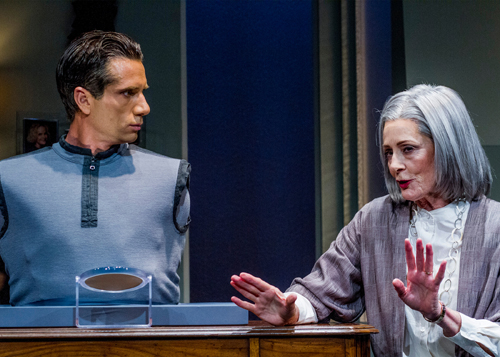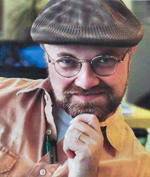
By Eric George Tauber

SAN DIEGO–Pinocchio, the Golem… age old stories. Can mortal man make creations in their own image and breathe life into them?
Actual robotics is experimenting with robots that have humanoid faces that can express emotion, but don’t really “feel” those emotions. Then again, haven’t we all faked our way through an awkward social interaction?
Bukimi no tani, “Uncanny Valley,” refers to “the discomfort people experience when seeing electronic recreations of human beings are not quite believable.” (press release)
“Turns out, the poets and artists aren’tthe definers of humanity. The techies are.”
This brings us to a laboratory in the mid-21st century. Claire is a robot scientist tasked with tutoring Julian in the art of seeming human. At first, he’s little more than a head on a desk. With each new scene, there’s more of him. Hats off to Sound Designer Kevin Antenhill who came up with the sounds of power tools integrated into music.
Nick Cagle is remarkable as the robot, Julian. His mime training comes through the robotic movements of his head and body, creating that “uncanny valley” through which we knew that he’s not quite human.
Local theatre icon Rosina Reynolds is delightful as Claire. Both scientific and motherly, Claire explains the world and is delighted by his independent insights. Certain personal topics make her visibly uncomfortable, but Julian can’t read the signs. Julian possesses both encyclopedic knowledge and child-like curiosity of the world, making unfiltered observations. It’s like a form of autism.
But Julian wasn’t created simply for the sake of science. He is the latest breakthrough in software that seeks to download memory and personality into a robot. Julian Barber is a multi-millionaire hoping to cheat death as his organic body succumbs to cancer. When the download is complete, Julian becomes cocky and calculating. The boyish charm is gone. He moves and speaks more naturalistically, and yet he retains subtle indications that he is still a robot.
The Sages teach that no one truly dies until there is no one left to remember us. If our memories can be digitally retained, are we then immortal? Can a robot really “be” a person or is it a machine that “thinks” it is that person?
Uncanny Valley is old-school, Twilight Zone style science fiction. It’s the kind of story that makes us really look at ourselves and poses perplexing existential questions.
If that’s your cup of tea, Uncanny Valley runs through May 10th at the Lyceum Space.
*
Tauber is a freelance writer who specializes in coverage of the arts. You may comment to him at eric.tauber@sdjewishworld.com, or post your comment on this website provided that the rules below are observed.
__________________________________________________________________
Care to comment? We require the following information on any letter for publication: 1) Your full name 2) Your city and state (or country) of residence. Letters lacking such information will be automatically deleted. San Diego Jewish World is intended as a forum for the entire Jewish community, whatever your political leanings. Letters may be posted below provided they are responsive to the article that prompted them, and civil in their tone. Ad hominem attacks against any religion, country, gender, race, sexual orientation, or physical disability will not be considered for publication. There is a limit of one letter per writer on any given day.
__________________________________________________________________